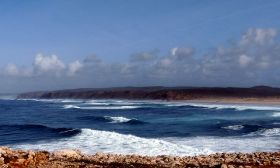How's the surf and surfing in and around Algarve?
Luis Teixeira da Silva - Algarve Senior Living
 Surfing in the Algarve is fantastic. Algarve is the second most popular region of Portugal for surfing. The most famous surfing spot can be found north of Lisbon, which is called the silver coast, in the area between Peniche and Nazare. They broke the world record there several times.
Surfing in the Algarve is fantastic. Algarve is the second most popular region of Portugal for surfing. The most famous surfing spot can be found north of Lisbon, which is called the silver coast, in the area between Peniche and Nazare. They broke the world record there several times. The Algarve has a fantastic reputation for surfing on the west coast of the region, between Sagres and Aljezur, and we have a number of famous beaches there such Bordeira and...
 Surfing in the Algarve is fantastic. Algarve is the second most popular region of Portugal for surfing. The most famous surfing spot can be found north of Lisbon, which is called the silver coast, in the area between Peniche and Nazare. They broke the world record there several times.
Surfing in the Algarve is fantastic. Algarve is the second most popular region of Portugal for surfing. The most famous surfing spot can be found north of Lisbon, which is called the silver coast, in the area between Peniche and Nazare. They broke the world record there several times. The Algarve has a fantastic reputation for surfing on the west coast of the region, between Sagres and Aljezur, and we have a number of famous beaches there such Bordeira and Carrapateira. We also have other beaches in and around the Sagres area, such as Martinhal and Baleal. They all have long, sandy beaches and very good surf. They have a fantastic swell and very evenly spaced waves. It’s easy to get a ride and get it in without being hammered by the next wave. But the water is cold so you need a wetsuit to go surfing.
There is also some surfing on the southern coast of the Algarve. The further west you go, the better the surf. There are small surfing spots just off the beaches around Lagos and around Praia da Luz. The distance between Lagos and Sagres is only about 25 kilometers so you don’t have to travel far to get to surf.
It’s safe to go into the water in Praia da Luz. The waters there are just like the Mediterranean most days. It is calm with azure colors; nary a wave so it’s very safe.
In the western part of the Algarve, you shouldn’t really go into the waves alone. If you have children, they can certainly play in the shallow water but I wouldn’t be far away because a lot of the beaches in that area are very remote and there are not a lot of people there. They don’t necessarily have protection such as life guards and so on. However, most of the southern beaches do have lifeguards.
The Algarve has probably the largest number of “Blue Flag” beaches in Portugal. “Blue Flag” is the European Union symbol for quality of the beaches, infrastructure and water quality. The beaches in the west coast has big waves whereas there are hardly any waves on the southern shores of the Algarve, so there are surf conditions to love for anybody.
(Swells at the beach at Carrapateira, Algarve, Portugal, pictured.)
Posted December 15, 2015


